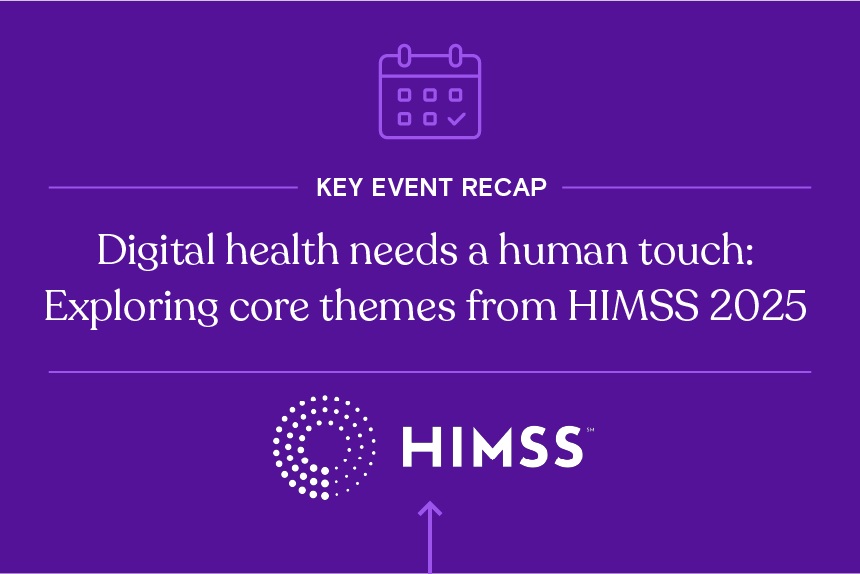Digital health needs a human touch: Exploring core themes from HIMSS 2025
Mar 12th, 2025

There’s no denying it: The energy at this year’s HIMSS Global Health Conference & Exhibition was next-level, even for Las Vegas. There’s something about bringing together tens of thousands of healthcare professionals, tech innovators, and thought leaders—and giving them a few days to discuss the future of their industry—that really gets a conference hall buzzing.
(And of course, being in Vegas doesn’t hurt.)
This year, at our booth and within dozens of sessions, conversations revolved around the transformative power of digital health, and how technology can enhance the human element of healthcare rather than replace it. Attendees and session leaders elevated the discussion beyond the buzzwords and examined the real-world impact—and potential risks—of several emerging technologies.
If you couldn’t make it to HIMSS 2025 or missed some of the most talked-about sessions, don’t worry—we’ve got you covered. Below, we’ll dive into the key themes that shaped HIMSS 2025.
Artificial and human intelligence work better together
While the theoretical potential for artificial intelligence offers ample fuel for conversation, HIMSS 2025 focused on the practical applications of this now-familiar technology. With numerous sessions (and an entire pavilion) dedicated to AI, there were plenty of nuances to explore, but the bulk of the discussion centered on integrating AI and machine learning in clinical practice to support physician judgement, reduce patient risk, and improve resource allocation.
In the keynote session, “Shaping the Future of Healthcare: A Collaborative Care Journey Where Technology and Humanity Coexist,” Dr. Seung Woo Park and Dr. Meong Hi Son of Samsung Medical Center in Seoul, South Korea, explained how they’re combining electronic medical record (EMR) data and AI with a human touch to enhance a variety of care processes.
Appearing onstage accompanied by Samsung’s pediatric care robots, Nova and Lumi, Dr. Park and Dr. Son outlined the creation of their Data Analytics and Research Window for Integrated kNowledge (DARWIN) initiative, designed to reduce physician burnout—and thus protect care continuity and patient experiences—by eliminating redundant workflows.
The doctors walked through the gradual process of creating an “intelligent” hospital, in which AI, patient data, and provider perspectives are integrated to streamline operations, save patients time, and improve care outcomes. They discussed the inherent tradeoff between flexibility and robustness in a provider’s capabilities, and the importance of respecting and incorporating physicians’ real-world experiences in a digitally integrated system.
Other sessions touched on:
- The role of predictive analytics for risk stratification and clinical decision-making
- The economic pressures forcing providers to seek relief from AI
- The impact of AI at the bedside
- Why healthcare providers should choose specialized AI models over generic options
Healthcare cybersecurity could be having its Sputnik moment
The topic of AI may have scored a pavilion, but cybersecurity landed its own “command center” at HIMSS 2025. The prioritization of cybersecurity should be unsurprising for anyone keeping an eye on the news these days, as data breaches and mishandling continue to impact healthcare providers, payors, patients, and governmental agencies.
Army General Paul Nakasone led the keynote address, “Adopting, Adapting, and Advancing: Harnessing the Power of Cyber and AI,” exploring the disruptive potential of digital health technology, the collaborative nature of cybersecurity, and the importance of AI-capable teams.
Gen. Nakasone drew from his experience leading cybersecurity in the U.S. intelligence community to highlight the threats that emerge with an increased reliance on information technology. He said that ransomware attacks against healthcare systems had increased 15% worldwide in the last year, noting that underfunded rural hospitals and clinics were especially vulnerable to such attacks.
The general said he hopes the rise of such data breaches becomes a “Sputnik moment” for healthcare, invoking the international space race of the 1950s that began after Russia launched the first satellite. Gen. Nakasone called for investing in a new generation of tech-forward clinicians (and clinically minded tech developers) to help the private and public sectors integrate AI safely and effectively.
The Cybersecurity Command Center hosted dozens of other sessions, exploring topics like:
- The necessity of cyber threat intelligence to combat increasingly sophisticated attacks
- The dark web, and its growing threat to healthcare organizations
- New methods for verifying healthcare employees’ and patients’ digital identities across platforms and facilities
- Using “cyber risk scores” to predict attacks and identify vulnerabilities
The industry is still working on interoperability
In case you haven’t already picked up on this blog’s structure, there was another specialty section at HIMSS 2025: the Interop + Smart Experience Pavilion.
Data interoperability remains a top priority for providers, and a number of sessions at this year’s conference centered on advancements in integration standards, patient data access and transparency, and the role of real-world evidence in improving care and operations.
Speakers from across the industry discussed why seamless data exchange is not just a benefit, but an integral component of patient care in a digital healthcare environment. Interoperability standards like HL7, FHIR, and OMOP are enabling otherwise disconnected healthcare systems to coordinate care and communicate more effectively, while technologies like AI-equipped EHRs, smart whiteboards, and “ambient listening” systems support faster and more accurate ingestion of patient data.
However, more data can rapidly become too much data. HIMSS 2025 also highlighted the challenges clinicians face as they attempt to parse and integrate massive amounts of patient information into their care plans. And while AI offers some useful solutions, conference attendees also learned how AI tools designed to fill in data gaps can hallucinate, leading to critical inaccuracies.
Tackling healthcare’s interoperability issue will require providers and technology developers to balance the data processing capabilities of AI with proactive cybersecurity and privacy measures, as well as leadership and training approaches that prioritize tech familiarity, data sensitivity, and ethical grounding. The industry may not have it all figured out by HIMSS 2026, but this year’s conference makes it clear that healthcare’s thought leaders are looking in the right direction.
Use the right data to humanize digital health
HIMSS 2025 showcased the convergence of medicine, technology, and the people that use and rely on both. Above all, the conference emphasized the importance of centering humanity in an increasingly digital healthcare space.
As healthcare delivery continues to transform, data makes it easier to understand and serve the people at its core, like patients, care professionals, life science developers, and care site administrators. Definitive Healthcare combines robust claims, reference and affiliation, and consumer behavioral data with powerful analytical tools to deliver insights into the people and markets your organization wants to reach. Sign up for a free trial today and see how our intelligence can help you unlock new opportunities.




